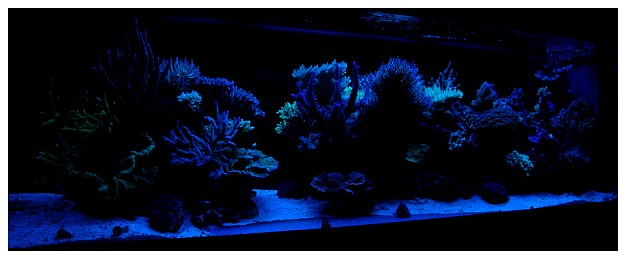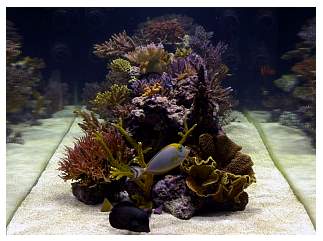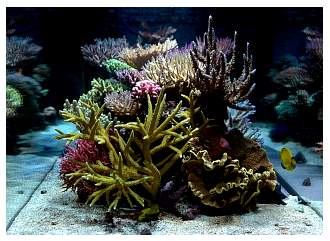|
Rudi Placht's (phocuz)
Reef Aquarium
Introduction
My interest in aquariums started almost five years ago after I got my diving certificate in Thailand and experienced the incredible animal kingdom beneath the water’s surface. It all started with a 25-liter freshwater tank, which didn’t last long. The aquarium quickly grew in size and changed from a freshwater system to saltwater. Since then, it’s fairly safe to say that my addiction has taken off a bit. Fortunately, I have a wife who is fairly interested in the hobby, and the fact that our two small daughters love the aquarium makes it easy to gain her acceptance of my hobby.
Last spring I bought a house that needed a total renovation. This gave me the freedom to set up an aquarium pretty much the way I wanted to have it. My goal was to create a stylistically pure, minimalistic aquarium that fit in with the rest of the living room. It would also be silent and would have no bothersome lights. From among many fantastic aquariums, Shawn Bennett’s old aquarium, without a doubt, inspired me the most. I wanted to set up a similar one with an open rock formation and plenty of space for the corals to grow.
Aquarium Profile
The aquarium is a custom-built WoHa with optiwhite glass and measures 200 cm L x 75 cm W x 60 H cm (900 liters). It’s set up in the living room as a dividing wall visible from three sides, and has been in operation since September 2006. The contents are from my old 325-liter aquarium.
 |
The floor is reinforced with extra supporting beams, and on the aquarium’s short side, furthest from the outer wall, a supporting wall has been erected on the floor below. The overflow is on the short side and is built with a 32-mm return, a 40-mm main overflow with a Durso standpipe and a 40-mm overflow that is a few centimeters higher than the main overflow for safety’s sake, to avoid flooding. The pipes continue downward to a room in the basement where all of the equipment is located, where they are connected to a 210-liter sump. The aquarium stands on a custom-built steel frame made by my LFS, and is built into the house, both above and below. Separate dedicated electrical circuits for the aquarium are installed in both the living room upstairs and the equipment room downstairs.
Lighting
Lighting consists of three 250-watt, 14.5K Giesemann metal halide bulbs. Supplemental lighting is provided by four 80-watt T5 actinics - two Actinic Plus and two Actinic Pure. The photoperiod begins with the actinics coming on two hours prior to the halides. The halides run for nine hours, followed by one hour of T5 actinics.
T5 Actinics: 09:00 - 21:00
Metal halide bulbs: 11:00 - 20:00
Water Movement
For circulation in the aquarium, I use four Tunze Stream pumps controlled by a Tunze Multicontroller: 2 x 20,000 liters/hour and 2 x 7,000 liters/hour. The pumps are installed on each side of the overflow, and are built-in so that they are not visible. In addition, the return pump circulates water from the sump at about 3,200 liters/hour.
Filtration and Equipment
I have used a minimum of live rock so that the corals have space to grow, and the fish have plenty of room to swim, while still providing them with some hiding places. Biological filtering is thus attended to with about 110 kg live rock.
Filtration is provided by a Deltec 1004 skimmer with an Eheim 1262 feed pump. The skimmer receives ozone via its one air intake. The water is filtered through some filter socks with carbon and through a chamber in the sump containing Cheatomorpha macroalgae. The algae have a photoperiod opposite that of the aquarium in order to generate less heat during the day and allow for a higher pH at night. Other equipment connected to the sump includes a Deltec 39-watt T5 UV light and a Deltec FR509 reactor filled with RowaPhos media, both of which run continuously.
The aquarium’s control unit is an IKS Aquastar computer (photo left). In addition to measuring the system’s pH and temperature, it controls the CO2 supply to a Deltec P601S calcium reactor. The calcium reactor is filled with A.R.M aragonite reactor media and keeps the calcium and alkalinity levels stable. In order to maintain constant values, the calcium reactor is set for pH 6.8 during the day and 7.1 at night. The IKS also controls an IKS Vario 180 peristaltic pump, which refills all evaporated water via a Deltec KM500S kalkwasser stirrer. Top-off water is refilled during the period when the metal halides are off. Two 400-watt submersible heaters and an Aqua Medic Titan 1500 chiller (photo below left) maintain a consistent temperature between 27 and 28 degrees Celsius.
Two quiet-running Pax bathroom fans (photo right) are installed above the aquarium. One fan is connected to the same timer as the metal halides, and blows straight across the water’s surface for cooling and air circulation in the canopy. The other fan draws the air above the aquarium out of the house to avoid humidity problems, as 16 liters of water evaporate daily.
When I started keeping small-polyped stony corals, I did all of the maintenance manually. Gradually, as my interest has increased, the number of gadgets has also increased, and most of the work is now done automatically. In addition to simplifying maintenance, the values are stable and the corals thrive much better than before.
Maintenance
|
Water
Parameters:
|
|
Ca:
420 ppm |
|
|
Alk: 10 dKH |
|
|
NO3, NO2, PO4: 0 |
|
|
Sr: 10 ppm |
|
|
Mg: 1450 ppm |
|
|
SG:~1.026 |
|
|
Temp:
27 - 28°C |
|
|
pH: 8.2 - 8.3 |
|
|
|
The skimmer top is cleaned once or twice each week. I change about 10% of the water every week/every other week. The spring water is filtered with the Kent Maxxima RO/DI system and is mixed with Tropic Marin Pro Reef Salt. I add Kent Turbo Strontium, Salifert Coralline Aminoacids, Tropic Marin Magnesium, Tropic Marin Pro-Coral A- Elements and Tropic Marin Pro-Coral K+ Elements daily/weekly.
Fish
There are many other fish that I would like to have, but I’m trying to keep the fish stock low to keep the nutrient level under control. After I acquired a Navarchus angel a few years ago, I really fell for angelfish. There’s something majestic about them, and their incredible colors make them natural eye-catchers in the aquarium. At present, I have a Goldflake, a Navarchus and a Potter, none of which bothers the SPS or the clams. In time, I’ll probably add more angelfish. The Flame Hawk is also one of my favorites. It jumps from rock to rock and pays close attention to everything that takes place outside the aquarium. It’s truly an entertaining fish. Fortunately, it doesn’t bother the shrimps.
1x Apolemichthys xanthopunctatus (Goldflake angel)
1x Pomacanthus navarchus (Majestic angel)
1x Centropyge potteri (Potter’s angel)
1x Naso lituratus (Naso tang)
1x Neocirrhitus armatus (Flame hawkfish)
1x Amphiprion ocellaris (Ocellaris clownfish)
1x Amphiprion percula (Percula clownfish)
2x Synchiropus picturatus (Spotted mandarin)
1x Pseudocheilinus hexataenia (Sixline wrasse)
1x Halichores iradius (Radiant wrasse)
1x Labroides dimidiatus (Cleaner wrasse)
Since I installed the new aquarium, I’ve tried a number of fish that haven’t been very successful. I had a juvenile Emperor angel for a month, but it nipped at the corals, and I had to remove it. I had a Clown trigger for a short while. It was a model citizen for a week, but then it became very destructive, pulling out and eating serpent stars and taking bites of Acropora. I guess individual differences come into play here, as with other fish, because I’ve seen several others keep them in a reef community tank. This amazing fish really got me thinking about setting up a fish-only aquarium at some point. Unfortunately, I had to remove my Zebrasoma gemmatum a few weeks ago. It was nipping at corals to an extent that made the corals look stressed. I had this fish for about 10 months, and it was really a shame that I had to remove it.
Corals
I have about 40 small-polyped stony corals - Acropora, Montipora, Stylophora, Pocillopora, Seriatopora, Turbinaria and Cyphastrea, as well as a few others. The majority of the corals were grown from small fragments. I also have two large-polyped stony corals, a Trachyphyllia and a Caulastrea. I used to have more LPS, but the angelfish were a little too fond of some of them, so I had to move the corals. I also have three Tridacna crocea and some Ricordea. Colorful SPS are, regrettably, in short supply in Norway, and this makes it very easy to envy the selection that’s available in the States.
Other Invertebrates
- Unknown number of assorted snails
- 2x Hermit crabs
- 8x Ophiolepsis superba (Tiger-striped serpent sea star)
- 5x Lysmata amboinensis (Cleaner shrimp)
- 3x Lysmata debelius (Blood Red Fire shrimp)
- 2x Astropecten polycanthus (Sand Sifting Sea Star)
- 2x Strombus alatus (Fighting conch)
- 1x Linckia laevigata (Linckia sea star, Blue)
|
|
Feeding
I try to give the fish as varied a diet as possible in order to avoid malnutrition. In addition, I feed them small amounts, and often. I’ve mixed Ocean Nutrition Formula One and Formula Two, Kent Herbivore and Carnivore and New Life Spectrum Pellets in an automatic feeder that feeds twice daily. I also feed them various frozen foods from Ocean Nutrition and San Francisco Bay Brand two or three times per week, O.S.I. Spirulina and O.S.I. Marine Flakes two or three times per week, and Julian Sprung’s Sea Veggies on a clip once per week.
Future Plans
One of the challenges I face is that I can’t seem to leave the aquarium alone. I’m always looking for ways to improve things. I’m also a diehard gadget junkie, and I love technical "stuff." Upcoming changes:
- Replace the 250-watt metal halide bulbs with 250 or 400-watters with Lumenarc reflectors. The light distribution from the lamps I have today is inadequate, and this is evident in a number of corals.
- Replace the IKS computer with an Aquatronica. The Aquatronica's innovation and functionality make it very interesting, particularly the ability to change the setup via the Internet and to receive updates via SMS if something is wrong. It’s great to have peace of mind when you’re on vacation.
- Upgrade the two smallest Tunze Stream pumps from 7,000 liters/hour to 12,000 liters/hour.
- Replace the sump with a larger one because the difference between the lowest water level before the return pump runs dry, and the highest water level before the sump overflows in a power outage, is small.
- I’m also considering connecting the water top-off system directly to the water pipes in the house so that the aquarium can go for longer periods without maintenance.
- Try to keep my hands out of the water.
 |
 |
|
Growth comparison pictures: left image was taken 9/8/06, right image taken 6/17/07. |
Acknowledgements
I would like to thank my wife, who truly supports me even though I spend too much time on the tank. I would also like to thank Reef Central and Reefkeeping Magazine for giving me the honor of presenting my aquarium, with additional thanks to the community that keeps Reef Central alive. Without countless hours of reading the forum/magazine, this aquarium wouldn’t be as it is today.
All photos by Rudi Placht
For more photos and information, visit my website: www.cowfish.info
Feel free to comment
or ask questions about my tank in the Tank of the Month thread on Reef Central.
|
If you'd like
to nominate a tank for Tank of the Month, click here
or use the button to the right. |
 |
|

